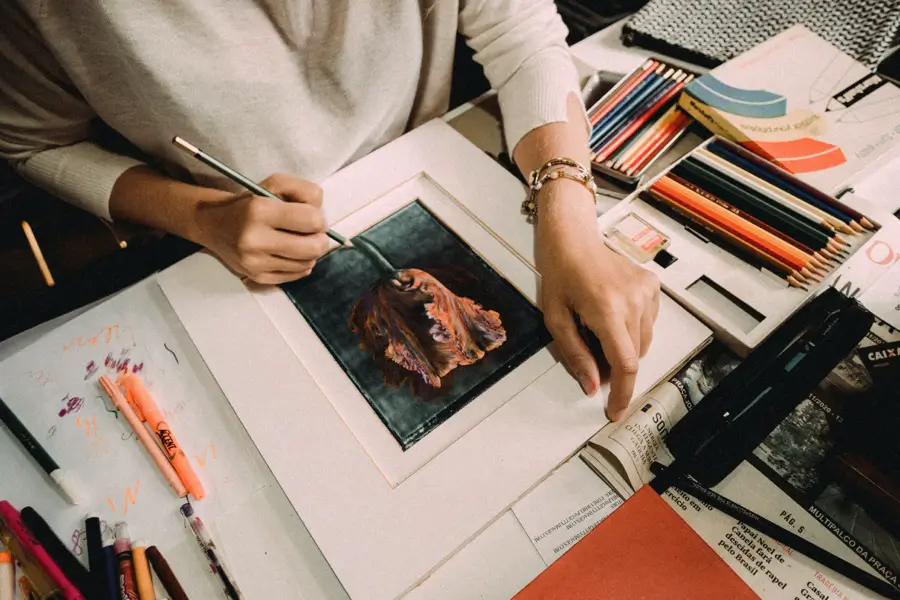
BUSINESS BASICS

Artistic pursuits are often associated with the “starving artist” stereotype, but it doesn’t have to be that way.
In this quick-start guide, we’ll explore practical strategies for artists to thrive financially and build successful art careers. By implementing these five key approaches, you can break free from the starving artist narrative and create a sustainable livelihood from your artistic passion.
The concept of the starving artist has its roots in romanticized notions of struggling artists throughout history. From Van Gogh to Mozart, the myth of the impoverished artist has been perpetuated through artistic narratives and societal beliefs.
However, it’s crucial to recognize that the art world has evolved, and success is not synonymous with suffering.
Contrary to the stereotype, many contemporary artists have found financial success while pursuing their creative endeavors. Artists like Damien Hirst, Yayoi Kusama, and Jeff Koons have achieved both critical acclaim and financial stability.
Their journeys highlight the possibilities for artists to thrive in today’s art market through strategic planning and business acumen.
Financial stability starts with effective budgeting. As an artist, it’s essential to track your income and expenses, create a realistic budget, and prioritize your spending.
This includes accounting for art supplies, studio rent, marketing expenses, and personal expenses. By having a clear understanding of your financial situation, you can make informed decisions and allocate resources wisely.
In addition to budgeting, saving and investing are crucial for long-term financial stability. Set aside a portion of your earnings for emergencies and future goals.
Consider working with a financial advisor who understands the unique financial needs of artists. They can help you explore investment options and develop a personalized plan to secure your financial future.
Relying solely on the sale of original artworks may limit your income potential. To avoid the starving artist scenario, explore diverse income streams. This can include offering art classes, workshops, or art-related services.
Consider selling prints, merchandise, or licensing your artwork for commercial use. By diversifying your income, you create multiple avenues for financial stability.
Commissions, freelance projects, and licensing opportunities can provide additional income and exposure. Collaborate with businesses, organizations, or individuals who value your artistic style and skills.
Commissioned works, freelance gigs, and licensing agreements allow you to expand your artistic reach and monetize your talent beyond traditional art sales.
Successful artists understand the importance of personal branding. Develop a strong and cohesive brand identity that reflects your artistic vision and resonates with your target audience.
Create a compelling artist statement, build a professional website or portfolio, and curate your online presence to showcase your work effectively.
Social media platforms and online art marketplaces provide valuable opportunities for exposure and sales. Leverage platforms like Instagram, Facebook, or Pinterest to share your artwork, engage with your audience, and attract potential buyers.
Explore online art galleries and marketplaces where you can showcase and sell your art to a global audience.
Art is constantly evolving, and staying informed about industry trends is crucial. Keep abreast of current artistic movements, emerging artists, and changes in the art market.
Attend exhibitions, art fairs, and conferences to network, gain inspiration, and stay connected with the larger artistic community.
Continuous learning and skill development are essential for artists seeking growth and new opportunities. Experiment with new mediums, techniques, or artistic styles to expand your artistic repertoire.
Invest in workshops, courses, or artist residencies that provide opportunities for artistic development and professional growth.
Artists can enhance their financial stability by embracing entrepreneurship and developing essential business skills.
Embracing an entrepreneurial mindset involves viewing your art as a business and actively seeking opportunities to generate income.
This mindset encourages artists to think strategically, identify market gaps, and create art that appeals to a target audience. By treating your art practice as a business, you can explore innovative ways to monetize your creativity.
To succeed as an artist, it’s crucial to develop fundamental business skills. This includes understanding marketing principles, pricing strategies, contract negotiation, and basic financial management.
Consider taking courses, workshops, or online resources that specifically focus on the business aspects of being an artist. These skills will empower you to make informed decisions, navigate business relationships, and optimize your financial success.
Networking plays a vital role in any artistic career. Connect with fellow artists, gallery owners, curators, and art professionals to expand your network. Attend art events, exhibitions, and industry conferences to meet potential clients, collaborators, and mentors.
Collaborative projects and partnerships can open doors to new opportunities, increase exposure, and generate income.
Invest in your professional development by participating in workshops, seminars, or artist residencies focused on entrepreneurship and business skills for artists.
These programs provide valuable insights into marketing strategies, business planning, and financial management tailored to the art industry. Take advantage of grants, scholarships, or funding opportunities to access these educational resources.
In today’s digital age, artists have unprecedented access to global audiences through technology and online platforms. Utilize e-commerce platforms, such as online art marketplaces or your own website, to sell your artwork directly to collectors worldwide.
Leverage social media and digital marketing techniques to promote your art and reach a broader audience. Embracing technology can amplify your artistic reach and income potential.
By implementing these five strategies—challenging the starving artist stereotype, practicing financial planning, diversifying your income, marketing your art effectively, and investing in continual learning—you can break free from the traditional notion of the starving artist. Embrace the possibilities of a thriving art career where your creativity flourishes, and financial stability is within reach.
Remember, being a successful artist is not only about talent and creativity but also about adopting a proactive and entrepreneurial mindset. With determination, strategic planning, and the right resources, you can navigate the art world with confidence and create a sustainable and fulfilling art career.

The Art Career Project is a trusted resource for emerging and professional artists.